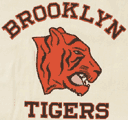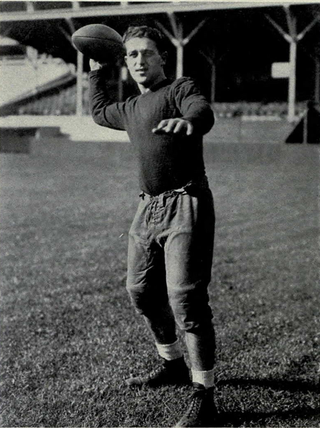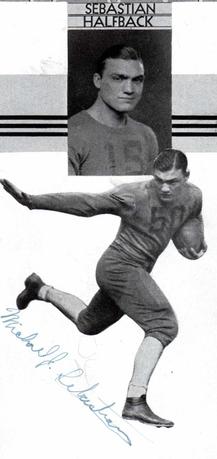Related Research Articles

The All-America Football Conference (AAFC) was a major professional American football league that challenged the established National Football League (NFL) from 1946 to 1949. One of the NFL's most formidable challengers, the AAFC attracted many of the nation's best players, and introduced many lasting innovations to the game. However, the AAFC was ultimately unable to sustain itself in competition with the NFL. After it folded, three of its teams were admitted to the NFL: the San Francisco 49ers, the Cleveland Browns and the original Baltimore Colts.

The Brooklyn Dodgers were an American football team that played in the National Football League from 1930 to 1943, and in 1944 as the Brooklyn Tigers. The team played its home games at Ebbets Field of the baseball National League's team, the Brooklyn Dodgers. In 1945, because of financial difficulties and the increasing scarcity of major league–level players because of the war-time defense requirements at the height of World War II, the team was merged with the Boston Yanks and were known as the Yanks for that season.
Below is a list of professional football Championship Games in the United States, involving:
The 1927 NFL season was the eighth regular season of the National Football League. Prior to the season, the league decided to eliminate the financially weaker teams. As a result, the league dropped from 22 to 12 teams. The league absorbed many players and one franchise from the defunct American Football League. Wilfrid Smith in the Chicago Tribune wrote that "the reduction formed a more compact circuit and provided better competition." Smith opined that the "outstanding feature" of the 1927 NFL season was the debut of Benny Friedman who became one of the game's "best drawing cards" and proved that professional football could support itself in Cleveland.
The 1945 NFL season was the 26th regular season of the National Football League. The Pittsburgh Steelers and the Chicago Cardinals resumed their traditional operations.
Throughout the years, a number of teams in the National Football League (NFL) have either moved or merged.
The first American Football League (AFL), sometimes called AFL I, AFLG, or the Grange League, was a professional American football league that operated in 1926. It was the first major competitor to the National Football League (NFL). Founded by Charles "C.C." Pyle, (1882–1939), and General Charles X. Zimmerman, (1865–1926), as vice president and starring Hall of Fame halfback Harold Edward "Red" Grange, (1903–1991), the short-lived league with nine teams competed against the more established – then six-year-old – NFL, both for players and for fans. While Pyle's and Grange's New York Yankees team and the already established Philadelphia Quakers became reliable draws, the lack of star power and the uncertain financial conditions of the other seven teams led to the league's dissolution after one season.
The Boston Bulldogs were a professional American football team that competed in the first American Football League in 1926. Owned by Robert McKirby, the Bulldogs lasted only six games into the AFL season, playing one home game in Braves Field and one in Fenway Park. Coached by player-coach Herb Treat, the majority of the team played their college football in New England, Pennsylvania, and New York. The offense, marked by its inconsistent performance was led by Joe McGlone was inconsistent, scoring a total of 20 points in its existence… 17 of which were tallied in one game. Erwin Gehrke and Carl Etelman shared the kicking duties. Bill Cronin, a tailback, scored the team's only offensive touchdown.

Harry Lawrence Newman was an American professional football player who was a quarterback in the National Football League (NFL) and American Football League. He played college football for the Michigan Wolverines (1930–32), for whom in 1932 he was a unanimous first-team All-American, and the recipient of the Douglas Fairbanks Trophy as Outstanding College Player of the Year, and the Helms Athletic Foundation Player of the Year Award, he was later inducted into the College Football Hall of Fame. He then played professionally for the New York Giants (1933–35), earning All-Pro honors, before joining the Brooklyn/Rochester Tigers (1936–37).

Michael John "Lefty" Sebastian was an American football halfback in the National Football League (NFL) for the Cincinnati Reds, Boston Redskins, Philadelphia Eagles, Pittsburgh Pirates, and the Cleveland Rams. Nicknamed the Rose of Sharon, he also played for the Rams while they were still members of the second American Football League (AFL) as well as the AFL's Rochester Tigers. Prior to his professional career, Sebastian played college football at the University of Pittsburgh. At Pitt, he played under coach Jock Sutherland, who had declared Sebastian the best passer whom he had seen in "many days."
The American Football League (AFL) was a professional American football league that operated in 1936 and 1937. The AFL operated in direct competition with the more established National Football League (NFL) throughout its existence. While the American media generally ignored its operation, this second AFL was the first "home" of the Cleveland Rams, which joined the National Football League after one year in the AFL.
The 1937 AFL season is the second and final season of the second American Football League. After the folding of the Syracuse/Rochester Braves in the 1936 season and the departure of the Cleveland Rams for the National Football League, the league added the Cincinnati Bengals and the Los Angeles Bulldogs, the latter being the first professional football team to play its home games on the American West Coast.
The American Association (AA) was a professional American football minor league based in New York City. Founded in 1936 with teams in New York and New Jersey, the AA extended its reach to Providence, Rhode Island prior to the onset of World War II. After a four-year hiatus, the league was renamed the American Football League as it expanded to include teams in Ohio and Pennsylvania. In 1947, the Richmond Rebels of the Dixie League purchased the assets of the defunct AFL Long Island Indians and jumped leagues.
The following is a timeline of franchise evolution in Major League Baseball. The histories of franchises in the National Association of Base Ball Players (NABBP), National Association of Professional Base Ball Players (NA), Union Association (UA), and American Association (AA) before they joined the National League (NL) are also included. In 1900 the minor league Western League renamed itself the American League (AL). All of the 1899 Western League teams were a part of the transformation with the Saint Paul Apostles moving to Chicago and to play as the White Stockings. In 1901 the AL declared itself a Major League. For its inaugural major league season the AL dropped its teams in Indianapolis, Buffalo and Minneapolis and replaced them with franchises in Boston, Philadelphia, and Baltimore and the Kansas City Blues moved to Washington to play as the Senators.

The Rochester Tigers were a professional American football team that competed in the second American Football League in 1936 and 1937. Owned by Mike Palm and Harry Newman, the Tigers were originally awarded to Rochester as a charter member of the AFL, but were shifted to Brooklyn two weeks afterward despite the lack of availability of a home stadium in its new home town, then moved back to Rochester midway through the 1936 season.
The Syracuse Braves were a professional American football team that competed in the second American Football League in 1936 and 1937. Coached by Don Irwin and Red Badgro, the Braves played in Municipal Stadium, which had a capacity of only about 10,000 people. The team was not a strong draw as it lost its first five games, prompting a search for a new home, including Providence, Rhode Island, before settling upon a move to Rochester.
The Pittsburgh Americans or Pittsburgh Amerks were a professional American football team based in Pittsburgh, Pennsylvania from 1936 until 1937. The team was a member of the major-league American Football League and participated in the league's 1936 and 1937 seasons.
This timeline of the National Football League (NFL) tracks the history of each of the league's 32 current franchises from the early days of the league, through its merger with the American Football League (AFL). The history of franchises that began as independent teams, or as members of the Ohio League, New York Pro Football League, and other defunct leagues are shown as well.
References
- 1 2 Bob Carroll, Michael Gershman, David Neft, and John Thorn, Total Football II: The Official Encyclopedia of the National Football League (HarperCollins 1999) ISBN 0-06-039232-0
- 1 2 George Gipe, The Great American Sports Book (Doubleday 1978) ISBN 0-385-13091-0
- ↑ History of Football in Western New York Archived September 19, 2011, at the Wayback Machine
- ↑ "Enciclopedia del football italiano - 1936 AFL season" (PDF). Archived from the original (PDF) on July 22, 2011. Retrieved November 10, 2008.
- ↑ Braves Lose Again, May Move to Rochester or Providence for Games - Oswego Palladium-Times, October 19, 1936